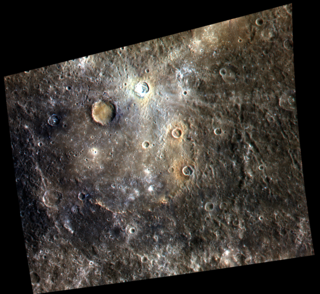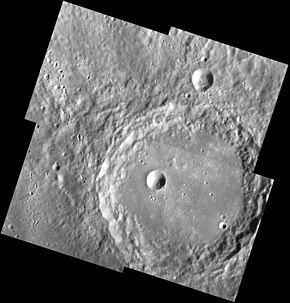
de Gerlache is a lunar impact crater that is located along the southern limb of the Moon, within a crater diameter of Shackleton at the south pole. From the Earth this crater is seen from the edge, and it lies in perpetual darkness. Thus little or no detail can be seen of this crater, other than the edge of the rim. However, the crater is clearly visible in Earth-based radar images. The crater is roughly circular, with some slight wear. No craters of note overlie the rim, although some formations may be attached to the southern and western edges.

Degas is a rayed crater on Mercury at latitude 37.5 N, longitude 127 W. Its diameter is 54 kilometres (34 mi). It was named after the French impressionist painter Edgar Degas in 1979. The rays consist of light colored material blasted out during the crater's formation. Craters older than Degas are covered by the ray material, while younger craters are seen superimposed on the rays. Degas forms a crater pair with Brontë to the north. Both lie near the center of Sobkou Planitia.

Volkov is a lunar impact crater on the Moon's far side. It is located to the north of the prominent crater Tsiolkovskiy, and east-southeast of Dobrovol'skiy. Overlying the southeastern rim of Volkov is the satellite crater Volkov J, and the two have merged to form a figure-8 shape. The crater Lander is attached to the southwest rim of Volkov J, making this a triple-crater formation.

Sobkou Planitia is a large basin on the planet Mercury. It is named after the ancient Egyptian messenger deity Sobkou. He was associated by the Egyptians with the planet Mercury.

Matisse is an impact crater on the southern hemisphere of Mercury. Matisse takes its name from the French artist Henri Matisse, and it was named by the IAU in 1976.

Raphael is a crater on Mercury. Its name was adopted by the International Astronomical Union (IAU) in 1976, and is named for the Italian painter Raphael.

Homer is a crater on Mercury. It is one of 110 peak ring basins on Mercury.

Brontë is a crater on Mercury. It has a diameter of 68 kilometres. Its name was adopted by the International Astronomical Union in 1976. Bronte is named for English writers Charlotte Brontë, who lived from 1816 to 1855, Emily Brontë, who lived from 1818 to 1848, and Anne Brontë, who lived from 1820 to 1849, and English writer and artist Branwell Brontë, who lived from 1817 to 1848.

Holbein is a crater on Mercury. Its name was adopted by the International Astronomical Union (IAU) in 1979. Holbein is named for the Germain painters Hans Holbein the Elder, who lived from 1465 to 1524, and Hans Holbein the Younger, who lived from 1497 to 1543.

Monet is a crater on Mercury. Its name was adopted by the International Astronomical Union (IAU) in 1979. Monet is named for the French artist Claude Monet, who lived from 1840 to 1926.

Neumann is a crater on Mercury. It has a diameter of 120 kilometers. Its name was adopted by the International Astronomical Union (IAU) in 1976. Neumann is named for the German architect Johann Balthasar Neumann, who lived from 1687 to 1753.

Enheduanna is a crater on Mercury. It has a diameter of 105 kilometers. Its name was suggested by Gagan Toor from India in a naming contest which was eventually adopted by the International Astronomical Union (IAU) on 2015. Enheduanna is named for the Sumerian poet Enheduanna. The craters Carolan, Kulthum, Karsh, and Rivera were also named as part of the contest.

Karsh is a crater on Mercury. It has a diameter of 58 kilometers. Its name was suggested by American resident Elizabeth Freeman Rosenzweig in a naming contest which was eventually adopted by the International Astronomical Union (IAU) on 2015. Karsh is named for the Armenian-Canadian photographer Yousuf Karsh. The craters Carolan, Enheduanna, Kulthum, and Rivera were also named as part of the contest.

Kulthum is a crater on Mercury. It has a diameter of 31 kilometers. Its name was suggested by Molouk Ba-Isa from Saudi Arabia, Swiss individual Riana Rakotoarimanana, and American residents Yehya Hassouna, David Suttles, Thorayya Said Giovannelli and Matt Giovannelli in a naming contest which was eventually adopted by the International Astronomical Union (IAU) on 2015. Kulthum is named for the Egyptian singer Umm Kulthum.















